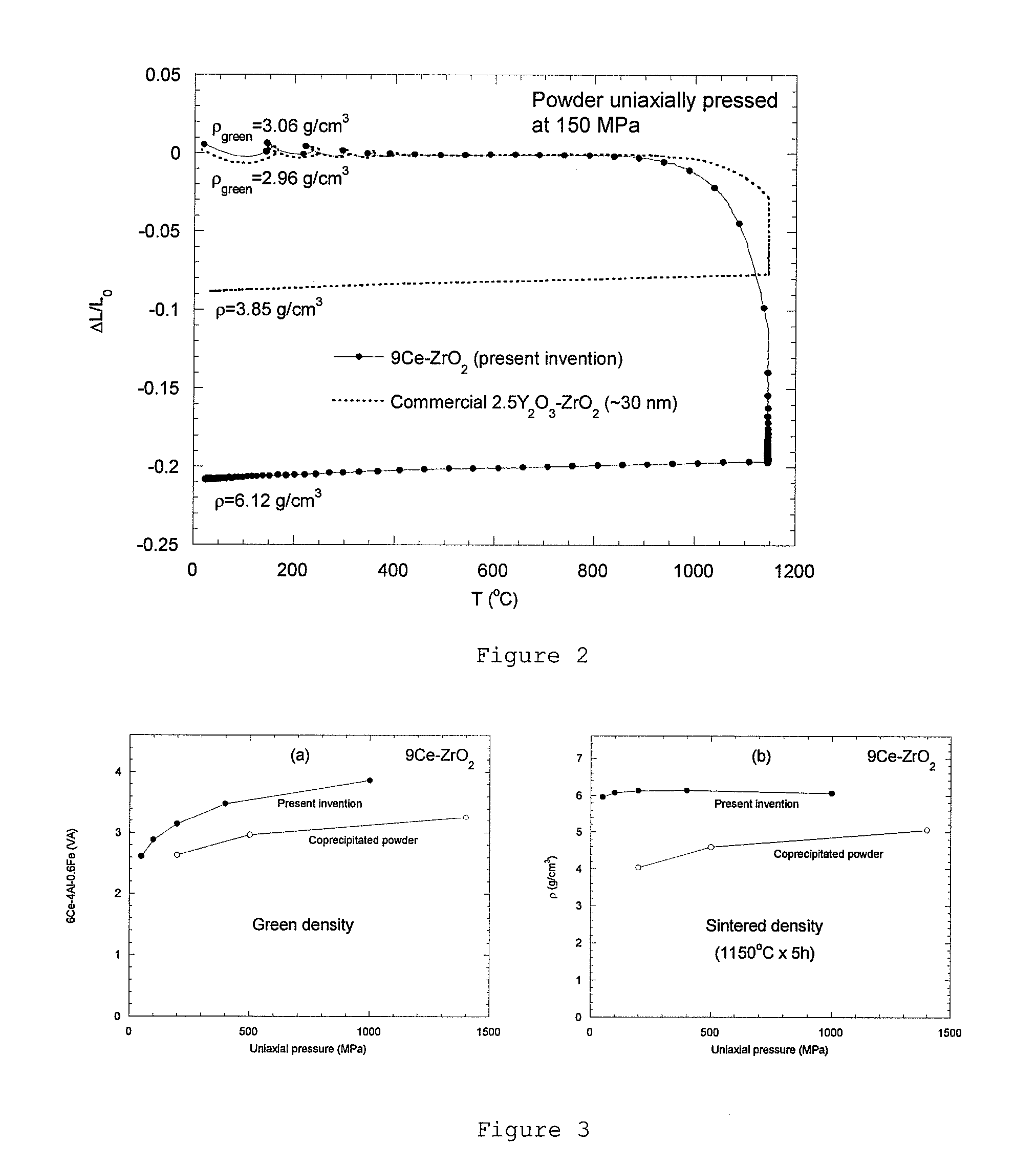Zirconia Ceramic
- Summary
- Abstract
- Description
- Claims
- Application Information
AI Technical Summary
Benefits of technology
Problems solved by technology
Method used
Image
Examples
example 1
[0086] A multi-component powder with an overall cation molar ratio of Zr:Ce=91:9 was prepared using a combination of mechanocamical processing of ZrOCl2.8H2O and a diluent phase of NaCl as described in US Pat. No. 6,203,768, the contents of which are incorporated herein by reference, and precipitation. The ZrOCl2.8H2O and NaCl were subjected to high energy ball milling then heat treated at a temperature of 750° C. after which the NaCl diluent phase was removed by washing with water. The product of this first stage is a slurry of 12 wt % nano-sized particles of zirconia suspended in water. The zirconia particles are kept in slurry form to avoid the formation of hard agglomerates that otherwise tend to form when nano-sized particles of zirconia are allowed to dry.
[0087] The average size of the nano-sized particles of zirconia in the slurry was about 20 nm with a relatively wide size distribution ranging approximately between 5 and 50 nm as illustrated in FIG. 1(a). The BET surface ar...
example 2
[0095] Multi-component powders with overall cation molar ratios of Zr: Ce:Al:Fe of 88.8:6:4:1.2 and 82.8:12:4:1.2 were prepared in the same way as in Example 1 except that appropriate amounts of Al2Cl4(OH)2 and FeCl3, as well as CeCl3.7H2O, were added to the slurry prior to the precipitation step.
[0096] Thermal expansion curves for green bodies prepared by uniaxial pressing of the multi-component powders at 150 MPa are shown in FIG. 5. Comparison with the curve for the 9Ce—ZrO2 multi-component powder described in Example 1 (shown with dotted line) clearly indicates that the multi-component powders containing Al and Fe sinter at lower temperatures. The data also indicate that the sintering temperature increases with Ce content. Separate sintering experiments showed that the multi-component powder containing 6% Ce, 4% Al and 1.2% Fe became essentially fully dense after sintering at 1120° C. for 3 h, while at least 1150° C. was necessary for the other two powders to become fully dense...
example 3
[0097] A multi-component powder with an overall cation molar ratio of Zr:Ce=70:30 was prepared in the same way as in Example 1 except that a zirconia powder containing 20% CeO2, instead of pure zirconia powder, was used and the amount of CeCl3.7H2O added to the slurry prior to the precipitation step was adjusted accordingly.
[0098] A green body obtained by uniaxial pressing at 150 MPa had a density of 3.21 g / cm3. The green body became almost fully dense (6.27 g / cm3) after sintering at 1200° C. for 5 hours. The crystal structure of the sintered zirconia ceramic was 100% cubic.
[0099] By contrast, a multi-component powder with the same cation molar ratio of Zr:Ce=70:30 prepared from pure zirconia particles, as in example 1, could not be sintered to full density even at 1250° C., because it contained too much cerium hydroxide.
PUM
| Property | Measurement | Unit |
|---|---|---|
| Temperature | aaaaa | aaaaa |
| Temperature | aaaaa | aaaaa |
| Temperature | aaaaa | aaaaa |
Abstract
Description
Claims
Application Information
 Login to View More
Login to View More - R&D
- Intellectual Property
- Life Sciences
- Materials
- Tech Scout
- Unparalleled Data Quality
- Higher Quality Content
- 60% Fewer Hallucinations
Browse by: Latest US Patents, China's latest patents, Technical Efficacy Thesaurus, Application Domain, Technology Topic, Popular Technical Reports.
© 2025 PatSnap. All rights reserved.Legal|Privacy policy|Modern Slavery Act Transparency Statement|Sitemap|About US| Contact US: help@patsnap.com



